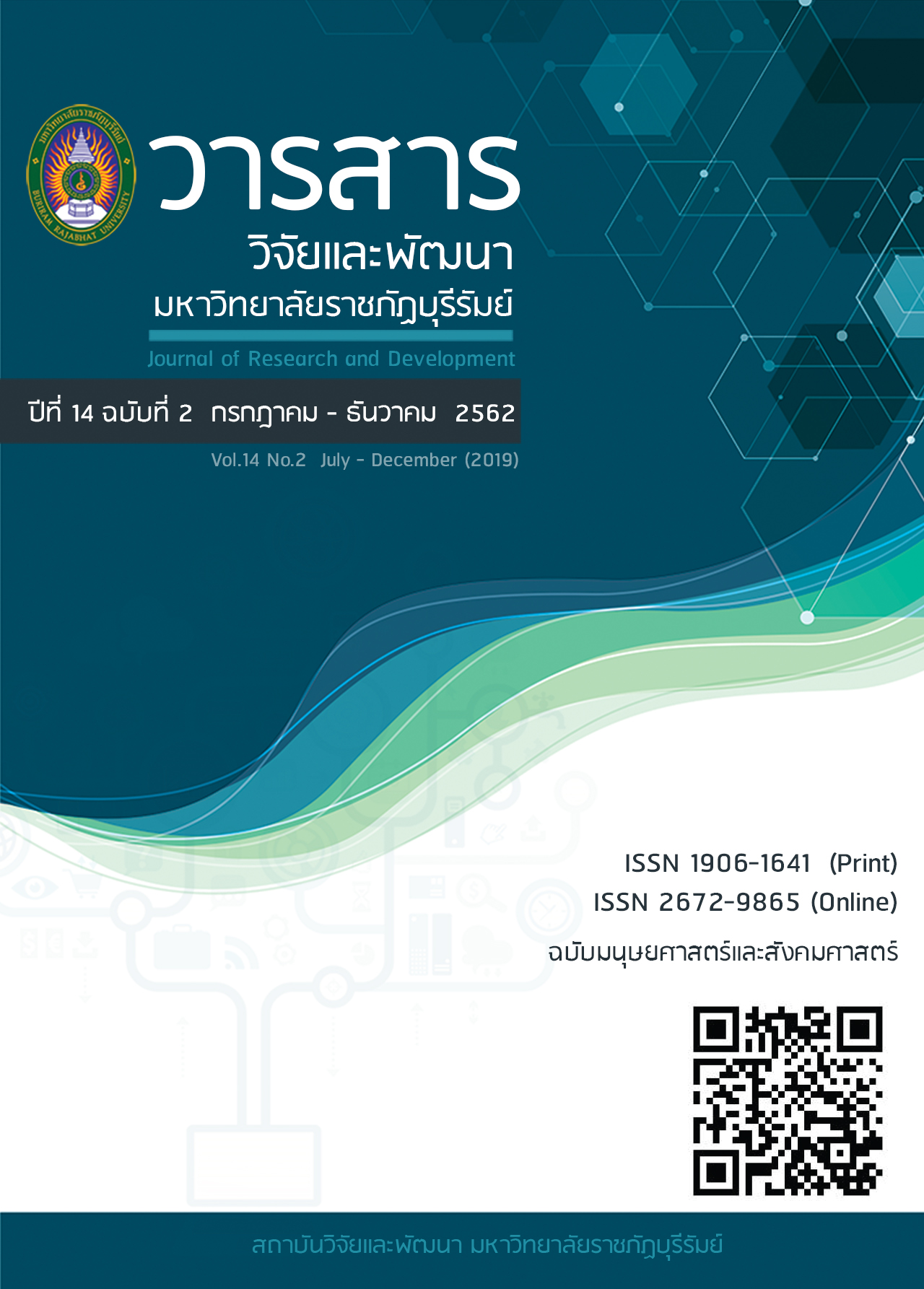หญิงงามกับชายทุรลักษณ์ในวรรณคดีร้อยกรองแบบฉบับ -
Main Article Content
บทคัดย่อ
บทคัดย่อ
บทความวิจัยนี้ มีวัตถุประสงค์เพื่อศึกษาบริบททางสังคมและวัฒนธรรมของหญิงงามและชายทุรลักษณ์ ในวรรณคดีร้อยกรองแบบฉบับ ตั้งแต่สมัยกรุงศรีอยุธยาถึงสมัยพระบาทสมเด็จพระมงกุฎเกล้าเจ้าอยู่หัวแห่งกรุงรัตนโกสินทร์ ผลการวิจัย พบว่าหญิงงาม ถูกกำหนดให้นำเสนอวัฒนธรรมหลัก ซึ่งมีสถานภาพทางสังคม รูปลักษณ์ การแสดงออกตามรูปแบบที่สังคมยอมรับ ในขณะที่ชายทุรลักษณ์ ถูกกำหนดให้นำเสนอวัฒนธรรมรองที่มีสถานภาพทางสังคม รูปลักษณ์ การแสดงออกที่ตรงข้ามกันและแปลกแยกจากรูปแบบที่สังคมกำหนด ส่วนบริบททางสังคมและวัฒนธรรม ได้นำเสนอผ่านตัวละครหญิงชายที่เป็นคู่ตรงข้ามกัน มี 3 ลักษณะ คือ 1. ชายแก่มี/อยากมีภรรยาสาว พบ 2 คู่ คืออมิตตดากับชูชก และจันท์สุดากับท้าวสันนุราช 2. ตัวละครหญิงงามมีฐานะทางสังคมสูงส่งกว่าตัวละครชายทุรลักษณ์ พบ 2 ประเภท คือประเภทแรกชายทุรลักษณ์ มีด้านชาติกำเนิดแท้จริงต่ำต้อย ปรากฏในคู่ของบุษบากับจรกา ลักษณะที่สอง คือหญิงงามและชายทุรลักษณ์ มีชาติกำเนิดแท้จริงเท่าเทียมกัน แต่ชายปลอมแปลงเป็นชายทุรลักษณ์ที่มีสถานภาพทางสังคมต่ำต้อยกว่าหญิง พบ 2 คู่ คือรจนากับเจ้าเงาะ และอุษากับแสนปม 3. ตัวละครชายทุรลักษณ์มีฐานะทางเศรษฐกิจสูงกว่าหญิงงาม พบในคู่ของวันทองกับขุนช้าง สำหรับผู้มีอำนาจ คือชนชั้นสูง ได้แก่ พระมหากษัตริย์และขุนนาง เป็นผู้ประกอบสร้างวรรณคดี จึงมีอำนาจในการกำหนดวัฒนธรรมหลัก และกดทับวัฒนธรรมรองซึ่งเป็นวัฒนธรรมของสามัญชนด้วยการนำวรรณคดีพื้นบ้านและขนบละครพื้นบ้านของสามัญชน มาแต่งสร้างในรูปของวรรณคดีราชสำนัก
Article Details
เนื่อหาและข้อมูลในบทความ เป็นความรับผิดชอบของผุ้แต่ง
บทความในวารสารเป็นลิขสิทธิ์ของวารสารวิจัยและนวัตกรรมท้องถิ่น
เอกสารอ้างอิง
กรมศิลปากร. (2543). บทละครเรื่องอิเหนา พระราชนิพนธ์ในพระบาทสมเด็จพระพุทธเลิศหล้านภาลัย. (พิมพ์ครั้งที่
14). กรุงเทพ ฯ: ศิลปาบรรณาคาร.
กรมศิลปากร. (2544ก). เสภาเรื่องขุนช้างขุนแผน เล่ม 1. (พิมพ์ครั้งที่ 18). กรุงเทพ ฯ: ศิลปาบรรณาคาร.
กรมศิลปากร. (2544ข). เสภาเรื่องขุนช้างขุนแผน เล่ม 2. (พิมพ์ครั้งที่ 18). กรุงเทพ ฯ: ศิลปาบรรณาคาร.
กรมศิลปากร. (2545). บทละครนอก พระราชนิพนธ์ในพระบาทสมเด็จพระพุทธเลิศหล้านภาลัย. (พิมพ์ครั้งที่ 10).
กรุงเทพ ฯ: ศิลปาบรรณาคาร.
กรมศิลปากร. (2513). ศกุนตลา มัทนะพาธา ท้าวแสนปม ประมวลสุภาษิต พระราชนิพนธ์ของสมเด็จ
พระรามาธิบดี มหาวชิราวุธ พระมงกุฎเกล้าเจ้าอยู่หัว. กรุงเทพ ฯ: บรรณาคาร.
กรมศิลปากร. (2514). เสือโคคำฉันท์ พระมหาราชครูแต่ง เสือโคคำกลอน คุณจง บุรานนท์ แต่ง. (พิมพ์เป็นอนุสรณ์
ในงานปลงศพคุณจง บุรานนท์). พระนคร: สามมิตร.
กรมศิลปากร. (2516). มหาชาติคำหลวง. (พิมพ์ครั้งที่ 6). กรุงเทพ ฯ: คลังวิทยา.
กรมศิลปากร. (2517). มหาเสสันดรชาดก ฉบับ 13 กัณฑ์. กรุงเทพ ฯ: คุรุสภา.
เกษม เพ็ญภินันท์ Alexandra Denas, Ph.D. และ รัตนา โตสกุล. (2552). ความโกลาหลของวัฒนธรรมศึกษา
ยกเครื่องเรื่องวัฒนธรรมศึกษา. กรุงเทพมหานคร: ศูนย์มานุษยวิทยาสิรินทร (องค์การมหาชน).
ขุนแผน. (2545). สืบค้นเมื่อ 21 ธันวาคม 2561, จาก https://library.mju.ac.th/film/detail.php?id=1406
ตรีศิลป์ บุญขจร. (2553). ด้วยแสงแห่งประทีปวรรณคดีเปรียบเทียบ วรรณคดีเปรียบเทียบ : กระบวนทัศน์
และวิธีการ. (พิมพ์ครั้งที่ 2). กรุงเทพ ฯ ศูนย์วรรรคดีศึกษา คณะอักษรศาสตรื จุฬาลงกรณ์มหาวิทยาลัย.
บันเทิง พาวิจิตร. (2547). สังคมวิทยา. กรุงเทพ ฯ: โอเดียนสโตร์.
ประจักษ์ ประภาพิทยากร. (2527). รายงานผลการวิจัยพระเอกในวรรณคดีคลาสสิคของไทย เรื่องขุนแผน : พระเอก
นักรบ. กรุงเทพ ฯ: สายส่งศึกษิต. 2527.
เพชรสุดา ทัศนพันธ์. (2542). แนวความคิดเรื่อง "การเข้าสมาคม" และผลกระทบต่อสตรีไทย พ.ศ. 2461-2475.
วิทยานิพนธ์ อ.ม., จุฬาลงกรณ์มหาวิทยาลัย.
เพ็ญประภา ภัทรานุกรม. (2549). มิติหญิงชายในงานสวัสดิการสังคม (Gender in SocialWelfare). กรุงเทพ ฯ:
มหาวิทยาลัยกริก.
วารุณี ภูริสินสิทธิ์. (ไม่ปรากฏวัน เดือน ปี ที่เผยแพร่). ความเป็นเพศ (Gender). สืบค้นเมื่อ 10 พฤษภาคม
2561, จาก https://www.midightuniv.org/midnightuniv/Newpage91.htm
วิกิพีเดีย สารานุกรมเสรี. (2561). สังข์ทอง. สืบค้นเมื่อ 8 กรกฎาคม 2561, จาก https://th.wikipedia.
org/wiki/
สุชาดา ทวีสิทธิ์ (บรรณาธิการ). (2547). เพศสภาวะ : การท้าทายร่าง การค้นหาตัวตน. เชียงใหม่: ศูนย์สตรีศึกษา
คณะสังคมศาสตร์ มหาวิทยาลัยเชียงใหม่.
สุพัตรา สุภาพ. (2545). สังคมวิทยา. (พิมพ์ครั้งที่ 22). กรุงเทพ ฯ: ไทยวัฒนาพานิช จำกัด.
อมรา พงศาพิชญ์, บรรณาธิการ. (2548). เพศสถานะและเพศวิถีในสังคมไทย. กรุงเทพ ฯ: จุฬาลงกรณ์
มหาวิทยาลัย.
Ruenruthai Sujjapun. (1995). Female Characters in Thai Narrative Poetry. (p.118-129). Thai Literary
Traditions. (Manas Chitakasaem, edited). Bangkok: Chulalongkorn University Press.


